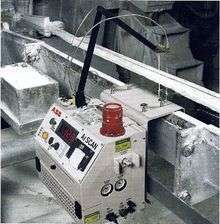Hydrogen gas porosity
Hydrogen gas porosity is an aluminium casting defect under the form of a porosity or void in an aluminium casting caused by a high level of hydrogen gas (H2) dissolved in the aluminium at liquid phase. Because the solubility of hydrogen in solid aluminium is much smaller than in liquid aluminium, when the aluminium freezes, the dissolved hydrogen gas creates porosity in solid aluminium.
Aluminum smelters and aluminum foundries want to produce high quality aluminum and shape castings with minimum porosity. This can be obtained by reducing the amount of hydrogen in the liquid aluminium alloy.
The hydrogen problem
Hydrogen forms whenever molten aluminium comes into contact with water vapor, and easily dissolves into the melt. The gas tends to come out of the solution and forms bubbles when the melt solidifies.
The detrimental effects arising from the presence of an excess of dissolved hydrogen in aluminium are numerous. Hydrogen causes porosity in aluminum products leading to many casting defects, reduced mechanical properties like fatigue and lower corrosion resistance. Several methods are used to reduce the amount of dissolved hydrogen from the melt, such as furnace fluxing prior to the casting process or using in-line degasing equipment[1] during the casting process.
Direct hydrogen measurement
An on-line method of measuring hydrogen in aluminum is then required to characterize and optimize the process, which helps ensure the quality of outgoing products and monitors the performance of these degassing processes. Traditional laboratory methods, such as hot extraction, are too expensive for routine quality assurance, and too slow for effective process control. The Reduced Pressure Test (RPT) is often used on the foundry floor. The RPT is a semi-quantitative method with limited accuracy that provides an indication of the hydrogen level.
Hydrogen analyzer

A hydrogen analyzer[2] can be used for direct measurement of hydrogen in liquid aluminium. Direct monitoring of hydrogen is possible using an on-line quantitative measurement technology based on a closed-loop gas recirculation method though a porous ceramic probe.
Since its introduction in 1989, this gas recirculation method has been increasingly used by major aluminum producers.[3]
Operation principle
The closed loop recirculation is a proven method of directly monitoring hydrogen in molten aluminium. A small volume of carrier gas, usually nitrogen, is brought in contact with the melt by means of an immersed probe, and is continuously recirculated in the closed loop until its hydrogen content reaches equilibrium with the vapor pressure of H2 in the melt. The H2 concentration in the gas is measured and converted into a reading of the gas concentration in the metal. This method is fast, reproducible and accurate, and can be used “on-line” on the cast shop floor.
The amount of H2 in the gas loop of the instrument is determined by a thermal conductivity sensor, which provides high reproducibility and a broad measurement range.
References
- ↑ Bernd Prillhofer, Holm Böttcher, DEVELOPMENT AND PRACTICAL PERFORMANCE CHARACTERISTICS OF A NEW IMPELLER FOR METAL TREATMENT IN CASTING/HOLDING FURNACES, Light Metals 2009, The Minerals, Metals & Materials Society
- ↑ Peter D. Waite, IMPROVED METALLURGICAL UNDERSTANDING OF THE ALCAN COMPACT DEGASSER, Light Metals 1998, The Minerals, Metals and Materials Society, 1998, pp 791-796
- ↑ In Situ Hydrogen Measurements in Liquid Al-Si foundry Alloys, Florence Paray, McGill University